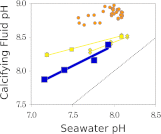Coral calcification feels the acid
- PMID: 23329329
- PMCID: PMC3562801
- DOI: 10.1073/pnas.1221308110
Coral calcification feels the acid
Conflict of interest statement
The author declares no conflict of interest.
Figures

Comment on
-
Impact of seawater acidification on pH at the tissue-skeleton interface and calcification in reef corals.Proc Natl Acad Sci U S A. 2013 Jan 29;110(5):1634-9. doi: 10.1073/pnas.1216153110. Epub 2012 Dec 31. Proc Natl Acad Sci U S A. 2013. PMID: 23277567 Free PMC article.
References
-
- Sabine CL, et al. The oceanic sink for anthropogenic CO2. Science. 2004;305(5682):367–371. - PubMed
-
- Gattuso J-P, Hansson L. Ocean Acidification. Oxford: Oxford Univ Press; 2011.
-
- Johnston I. The ultra structure of skeletogenesis in hermatypic corals. Int Rev Cytol. 1980;67:171–214.
-
- Hemming N, Hanson G. Boron isotopic composition and concentration in modern marine carbonates. Geochim Cosmochim Acta. 1992;56:537–543.
Publication types
MeSH terms
Substances
LinkOut - more resources
Full Text Sources
Other Literature Sources

